

Brakes – Don’t risk your safety
Upgrade Your Breaks
Your Trusted Tyres Experts Since 2008.
GET A FREE QUOTE
When Do Car Brakes Need Replacing?
Car brakes need replacing when the brake pads, discs, or other components show signs of wear or damage. Typically, front brakes wear out faster than rear brakes, but replacement timing depends on driving habits, road conditions, and the type of brake components used. Below are key indicators that it might be time to replace your car brakes:
1
Squeaky Brakes
A high-pitched squealing noise when applying the brakes often indicates that the brake pads are worn. Brake pads include a built-in wear indicator that emits this noise as a reminder to replace them.
2
High Handbrake
If the handbrake requires excessive force or pulls up higher than usual, it could be due to worn brake shoes, stretched cables, or a faulty handbrake mechanism. This indicates it’s time for inspection and potential replacement.
3
Soft Brake Pedal
A brake pedal that feels soft or spongy may indicate air in the brake lines, a brake fluid leak, or an issue with the master cylinder. This condition compromises braking performance and requires immediate attention.
4
Spongy Brake Pedal
Sponginess in the brake pedal, lacking firmness, is often caused by air or moisture in the brake lines, brake fluid leaks, or improper brake bleeding. Addressing this promptly is crucial for maintaining effective braking.
5
Grinding Noise
Grinding sounds when braking suggest the brake pads have worn down completely, and metal contact is occurring between the pad backing and the brake disc. This metal-on-metal contact can damage the brake discs and significantly reduce braking efficiency.
6
Pulsating Brake Pedal
A pulsating or vibrating brake pedal, often felt during braking, usually indicates warped brake discs. Excessive heat buildup, aggressive braking, or worn pads can lead to disc warping, resulting in an uneven braking surface.
7
Vehicle Pulling to One Side
If your vehicle pulls to one side while braking, it may indicate an imbalance in brake performance, such as uneven pad wear, a stuck calliper, or brake hose issues. Addressing these problems ensures balanced and effective braking.
8
Brake Warning Light
A brake warning light on the dashboard can indicate issues such as low brake fluid, worn pads, ABS malfunctions, or other faults in the brake system. Immediate inspection is necessary to identify and resolve the issue.
If you experience any of these warning signs, it’s essential to have your brakes inspected by a qualified mechanic. Addressing brake issues promptly ensures your safety and restores your vehicle’s optimal braking performance.
